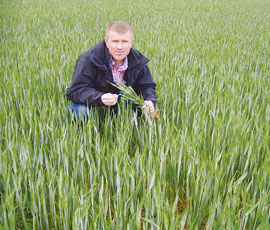Disease pressure alert for winter wheat

The current mild winter weather could increase the disease pressure this spring with forward crops and a near record wheat area heightening the risk.
Septoria and yellow rust are likely to be the biggest headaches for growers, with the latter already troubling some winter wheat fields.
The lack of a cold snap and early drilling has also increased the risk of the stem-based disease eyespot, with growers needing to be vigilant early in the spring for signs of stem-base browning.
Despite this, experts say there is potential for a bumper wheat crop in 2014 as long as growers adopt full fungicide programmes using the new generation of SDHI products.
Last season’s wet weather and backward crops culminated in a low disease year with widespread septoria not being seen until late May, and winter wheat crops senescing soon after in the summer heatwave.
The winter wheat harvested area in 2013 was also significantly reduced, with a larger portion of spring crops helping to ease disease problems.
Growers were restricted in applying fungicides in the late spring, with many missing their T1 timings leading to a reduction in this market.
BASF’s UK fungicide product manager Peter Hughes (pictured above) says despite the 21% decrease in the overall cereal fungicide market last season the SDHI products increased their market share.
The advent of this new generation of SDHIs has seen a reduction in older strobilurins products, with SDHI’s and triazoles making up over 85% of the wheat fungicide market.
Steve Dennis, technical agronomy manager at BASF, says SDHI chemistry in particular could become even more important this year and growers need to monitor disease-susceptible varieties.
“This year we are set up to see a high disease year. You don’t want to be stifling your yield by cutting corners on your fungicide programme,” he told a recent briefing.
Mr Dennis added that in a high disease such as 2012 yield responses from using fungicides were about 4-5t/ha, and even in the low disease of 2013 the response was some 1t/ha.
Early timing
This season, the early T0 timing will be key in tackling any yellow rust and mildew according to Mr Dennis, who added that timings will be critical with mildew difficult to eradicate if not controlled early.
“Triazoles will play a big role in early fungicide treatments, so you should the best triazole you can, even if you are using it again in the programme,” he said.
A triazole plus chlorothalonil product is usually favoured at T0 according to Mr Dennis.
At T1, Mr Dennis says growers need to ensure the high eyespot risk is managed along with septoria and rusts, and at this timing he advises BASF’s Tracker, while the survey also reported Proline as a popular product.
Covering the main diseases at the T2 timing will also be important, with septoria, yellow rust and brown rust all posing a threat. The new generation of SDHI’s are generally seen as most effective at this T2 flag-leaf stage used in conjunction with triazoles.
He added that maintaining product efficacy is vital by using fungicides with different modes of action.
“Chlorothalonil can play a big role in helping this, improving the efficacy in certain products such as Adexar and reducing the risk of resistance,” explained Mr Dennis
A new independent survey of 40 independent adviser and funded by BASF showed that septoria control was one of the biggest drivers for SDHI choice, closely followed by yellow rust.
SDHI-trizoles products Adexar and Aviator came out on top for septoria control, while BASF’s Adexar gave the most improved yellow rust control closely followed by Seguris.
The SDHI newcomer Vertisan also gave positive results in the survey in its first year of widespread use in 2013.
(more on Spring wheat helps growers to beat blackgrass)


